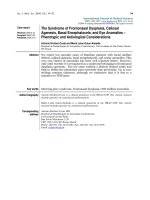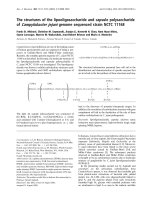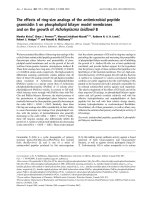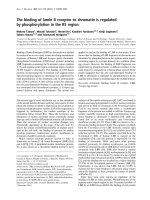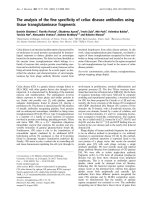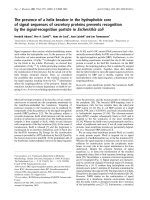Báo cáo y học: "The Geography of Chronic Obstructive Pulmonary Disease Across Time: California in 1993 and 1999"
Bạn đang xem bản rút gọn của tài liệu. Xem và tải ngay bản đầy đủ của tài liệu tại đây (1.54 MB, 11 trang )
Int. J. Med. Sci. 2007, 4
179
International Journal of Medical Sciences
ISSN 1449-1907 www.medsci.org 2007 4(4):179-189
© Ivyspring International Publisher. All rights reserved
Research Paper
The Geography of Chronic Obstructive Pulmonary Disease Across Time:
California in 1993 and 1999
Robert Lipton and Anirudhha Banerjee
Prevention Research Center, 1995 University Ave. Suite 450, Berkeley, CA 94704, USA
Correspondence to: Robert Lipton, Ph.D., Research Scientist, phone: 510 883 5755, fax: 510 644 0594, email:
Received: 2007.05.02; Accepted: 2007.06.13; Published: 2007.06.28
We investigated changes in the geography of Chronic Obstructuve Pulmonary Disease (COPD) hospitalization
charges in California over the period of 1993 and 1999. There is little information available at less than the county
level for this increasingly costly disease in California. We found, using a uniform grid unit method, (4X4 and
16X16 mile urban and rural grids respectively, using zip codes as the base source for information) positive rela-
tionships between COPD charges and age, percentage Hispanics, and number of tobacco outlets. Further, inverse
relationships were found between the incidence of COPD charges and income level and the percentage of the
population with undergraduate degrees. When examining “hotspot” grid units, we found that COPD was clearly
associated with minority/immigrant status and depressed socio-economic measures, suggesting the need for
better smoking interventions among persons of color and the poor. In summary, the Los Angeles area had a
marked increase in hotspots both in 1993 and 1999, and also experienced a significant increase in COPD hospi-
talization charges between 1993 and 1999. Transforming zip code level data into a uniform grid allows for rela-
tively simple comparisons across time, without such a transformation, such temporal comparisons are extremely
difficult to implement. This more, “fine grained” geographical analysis allows public health planners a better
platform than is typically available to assess changes in COPD.
Key words: chronic obstructive pulmonary disease, spatial analysis, uniform grid, tobacco related disease, hot spots
1. INTRODUCTION
Chronic obstructive pulmonary disease (COPD)
morbidity and mortality represent a major public
health concern both in the U.S. and worldwide. As of
2002, 16 million U.S. residents were estimated to suffer
from COPD, primarily from chronic bronchitis.
Moreover, this problem appears to be worsening, as
the prevalence of COPD is increasing in the elderly
and female populations [1]. Overall, COPD-related
mortality has markedly increased, from the twelfth
cause of death in 1990 to its current position as the
fourth leading cause of death in the U.S. and world-
wide [2, 3, 4]. Approximately 120,000 adults (25 years
of age and older) died from COPD in 2000 in the US.
Although the COPD death rate for women doubled
between 1980 and 2000, the age-adjusted death rate for
men was 43% higher. Since 2000, yearly death rates for
women have been higher than for men.
The increasing incidence of COPD is reflected in
increasing health care costs to treat and care for pa-
tients. The total cost of COPD in the U.S. was ap-
proximately $32 billion dollars in 2002. And these costs
are far from complete, as it is estimated that less than
half of U.S. COPD cases are diagnosed (i.e., 14 to 46
percent),with females much less likely than males to be
diagnosed. While hospitalization costs comprise the
bulk of the cost burden for COPD disease, additional
high costs are associated with long-term oxygen ther-
apy, the only effective therapy for decreasing
COPD-related deaths [4].
How might these increased costs be considered in
a global context? The global burden of disease study
conducted by the World Bank estimates that by the
year 2020, COPD will be the number three killer
worldwide, and the number five ranked disease for
disability-adjusted life years lost (DALYs) [1]. Simi-
larly, Izquierdo (2003) conducted an economic analysis
of a large international survey, Confronting COPD in
North America and Europe, and found the annual cost of
COPD to the healthcare system was Euro 3,238 per
patient, plus indirect costs amounting to Euro 300 per
patient [5]. In Spain, a significant proportion of the
economic burden of COPD on the Spanish healthcare
system was associated with inpatient hospitalization
(Euro 2,708), which accounted for almost 84% of the
total direct cost of the disease. The impact of COPD on
the healthcare system may also be due to un-
der-diagnosis and treatment of COPD, suggesting the
need for improved early detection and primary care.
Earlier diagnosis of COPD could help ameliorate more
serious and costly complications, Lipton et al, 2005.
The sub-analysis of costs from the survey showed that
patients with severe COPD were associated with con-
siderably higher total societal costs than patients with
mild disease (Euro 9,850 versus Euro 1,316 per pa-
tient). Izquierdo (2003) concluded that introducing
interventions to reduce patients’ progression to severe
COPD could help reduce the economic impact of the
Int. J. Med. Sci. 2007, 4
180
disease [5].
How do we account for these increases in rates of
COPD? Chronic obstructive pulmonary disease
(COPD) is a condition characterized by progressive
airflow limitation, which causes considerable morbid-
ity and mortality worldwide. Between 80 and 90% of
COPD cases are due to cigarette smoking, while addi-
tional cases are due to serious lung infections, envi-
ronmental causes, or genetic conditions [5,6]. Yet the
prevalence of COPD is poorly understood and the
healthcare costs associated with the disease are poorly
characterized. Few studies have attempted to quantify
the impact of the disease on patient health, the
healthcare system, caregivers and family members,
and society as a whole [6] and little is known about its
behavioral, socio-economic or environmental etiology.
COPD in California
As the nation’s most populous state, California
has experienced a great deal of population growth in
the last decade, and approximately 10 percent of the
U.S. population resides in the state. Moreover, it is a
state characterized by significant cultural and eco-
nomic diversity and thus provides an opportunity to
consider the distribution of the disease relative to a
number of socio-demographic, environmental and
behavioral (most notably smoking) characteristics.
Approximately 1.6 million people are afflicted with
COPD within the state of California [6]). Given the fact
that COPD is a very expensive disease to treat as well
as costly in regard to premature morbidity and mor-
tality, it is imperative that we develop a thorough un-
derstanding of the dimensions of this disease, both in
terms of costs and prevalence. Motivated by this con-
cern, this analysis will examine the geographic distri-
bution of COPD in California for the years 1993 and
1999 relative to background demographic, environ-
mental and behavioral characteristics in the state.
An additional feature of this study is the use of
geospatial methodology, which has the potential to
improve the estimation of COPD prevalence. At pre-
sent, relatively little is known about the spatial distri-
bution of COPD prevalence and disease-related hos-
pitalization charges in California over time, particu-
larly at any level of analysis smaller than the county.
Possible geographic differences in COPD can easily be
obscured at this relatively large areal level. Therefore,
in this analysis, we examined COPD hospitalization
charges by smaller geographic areas, e.g. Zip Code
Tabulation Area (ZCTAs) units.
Our use of geospatial methodologies also pro-
vides tools for integrating socio-demographic charac-
teristics and tobacco use information across geo-
graphic areas that are not possible with more tradi-
tional non-spatial methodologies. Further, mapping of
population density, major roads, air pollution data,
can, depending on the needs of researchers and plan-
ners, be easily included. In addition, by using spatial
modeling our analysis identifies geographic areas with
higher-than-expected hospitalization charges related
to COPD. The panel design, which compares hospi-
talization charges for two time periods, 1993 and 1999,
also allows us to assess changing patterns of COPD
healthcare charges in a time of rapid population
growth. Lastly, our analysis is augmented by a novel
approach toward interpolating Zip Code Tabulation
Area (ZCTA) units into a uniform geographic grid that
allows us to compare consistent geographic areas over
time. This research can help public health and policy
planners more clearly identify where high levels of
TRD occur in the state. Indeed, this approach allows
for the efficient identification of clusters of high rates
of disease while controlling for salient
socio-demographic measures.
2. METHODS
Health Data
As defined by the U.S. Census, Zip Code Tabula-
tion Areas (ZCTA) are “areas that approximate the
areas covered by the U.S. Postal Service’s five-digit or
three-digit ZIP Code” [7]. All information used in this
analysis was available at the ZCTA level, and for this
analysis we initially used all 1,527 ZCTA units for
1993, and all 1,707 ZCTA units for the entire state of
California in 1999. We geo-coded addresses by ZCTAs
for the 1999 data and joined them with the U.S. Census
Bureau summary files 3 (SF-3) for ZCTAs. One of the
benefits of using ZCTAs is that the SF-3 Census 2000
data contain detailed information for
socio-demographic variables. Zip code level informa-
tion was then transformed into uniform grid informa-
tion (as discussed at length below) for both time peri-
ods. The asymmetric nature of the number of zip codes
prompted us to choose a regular grid that was sym-
metrical and suitable for panel data analysis.
We collected annual audited Hospital Discharge
Data (HDD) for all inpatients discharged from hospi-
tals licensed by the State of California, as submitted to
the Medical Information Reporting for California Sys-
tem [8]. According to HDD, there were approximately
3,664,629 million patient records available in 1993, and
3,775,711 million patient records available in 1999.
These data contain pertinent information for diagnosis,
reason for hospital stay and charges for stay. Using
these records, we used hospitalization counts of
COPD, defined as ICD-9 codes 490-492, 494, 496, as a
way to estimate COPD charges. Due to re-admittance,
our method is therefore not an exact estimate of COPD
related hospitalization charges, but rather an ap-
proximation of initial charges. Since hospital admis-
sions data do not code for readmission, readmission
issues are not addressed in total charges. However, it
can be assumed that biased geographic variability of
readmission rates are insignificant; i.e., that differences
in readmission rates are randomly distributed
throughout the state. Similarly, although total charges
are not complete, they are assumed to be distributed in
an unbiased manner throughout the state.
The main point of this analysis is to robustly de-
scribe the spatial pattern of COPD charges; we are not
attempting to etiologically explain this distribution as
much as we are attempting to give health planners
better information about the geography of this illness
Int. J. Med. Sci. 2007, 4
181
in California. Asthma was explicitly excluded from
this analysis because asthma is not as specific to
smoking as are other diseases typically included in the
spectrum of illnesses falling under the rubric of COPD.
We should also mention that our information re-
garding COPD charges excluded data from the Kaiser
hospital network (accounting for approximately
one-sixth of the patient population in California), and
data on patients insured at Shriner Hospital. However,
these insurance companies are located in urban areas
in California with consistent proportions of members
across geographic areas, and their absence does little to
skew the total charges by geographic area. The Hos-
pital Discharge Data provides robust numbers for ill-
ness by ICD-9 definitions (Lipton et al, 2005).
Socio-demographic Variables
Age, income, education, ethnicity/race, house-
hold information, and immigrant status were obtained
from United States Census data from the years 1990
and 2000. Data from these years corresponded most
closely with Hospital Discharge Data from 1993 and
1999.
Smoking Prevalence Data
Tobacco outlet information was estimated from
California Alcohol Beverage Commission information
from 1993 and 1999. We collected data from three
types of outlets: restaurants, bars and off-premise
stores (e.g., liquor stores, grocery stores, etc). With few
exceptions, this latter category also sells tobacco
products, and thus we used off-premise alcohol outlets
as a surrogate estimate for number of tobacco outlets.
Clearly, this is a conservative estimate of the number
of tobacco outlets throughout the state as tobacco can
be bought at locations other than off-premise alcohol
outlets.
Spatial Modeling
Areas that are close in proximity are usually more
alike, across a variety of demographic and environ-
mental factors, then areas that are farther away from
each other. When including areal information, such as
income by zip code or education by census tract in an
analysis, not taking into account area proximity could
result in less precise results (statistical bias). To be
clear, the placing of an administrative geographic ma-
trix such as zip codes over the actual places people live
requires a spatial adjustment of some sort. Indeed,
correlated measurement error between spatial units
often occurs in analyses of geographic data and can be
a source of substantial bias in statistical tests. Given the
fact that measurement errors between adjacent units
tend to be correlated however, means that spatial
autocorrelation or over-sampling errors can be cor-
rected using spatial statistical models. Generalized
least squares (GLS) estimators are available for this
purpose and provide unbiased estimates of effects and
diagnostics for this form of correlated measurement
error [9, 10, 11, 12].
Moran’s “I” statistic (MC) is a weighted correla-
tion coefficient used to detect departures from spatial
“unbiasness.” It measures spatial autocorrelation us-
ing a non-parametric procedure [13]. Using Moran’s
“I” statistics with this data, it was evident that
large-scale spatial autocorrelation existed if Hospital
Discharge Data were aggregated at the ZCTA level.
The MC for total COPD charges was 0.75 in 1999, while
the expected value for MC was -0.0004 (or approxi-
mately the theoretical mean of zero). For 1993, the MC
was 0.73 with the same expected value of zero. This
relatively high level of spatial bias required "adjust-
ment" before regression results could be coherently
assessed. Spatial regression is defined as non-linear
regression that requires “weighting” to correct for
autocorrelation. In this regard, it was possible to adjust
for spatial autocorrelations using S
3
(a set of Mathe-
matica ™ commands developed for space-time regres-
sion models) [14], as the software, by definition, ad-
justs for autocorrelation bias.
Transforming Zip Code Level Data Into A
Geo-Spatial Grid
Due to its primarily administrative and political
nature, Zip code information is quite difficult to use for
panel data analysis and public health purposes. Using
irregular area units (like zip codes) for calculating
disease risks poses problems of geo-statistical consis-
tency. Changing the boundaries of collection units or
grouping them differently produces different spatial
patterns and gives rise to the Modifiable Areal Unit
Problem or MAUP [15]. The ecological inference
problem (or ecological fallacy; [16]), which refers to the
failure to incorporate relevant, spatial information
about individuals that changes the summary statistics,
is a more generalized form of the MAUP.
According to Gotway [17], the MAUP and eco-
logical fallacy are special cases of a mathematically
well-defined problem known as the change of support
problem (or COSP). COSP addresses the "specification
bias" that can violate the properties of statistical in-
ference and underpins the basis of probability theory
[18, 19]. Gotway and Young [17] outline a combination
of spatial smoothing and geostatistical upscaling or
aggregation of data with point support to avoid statis-
tical pitfalls associated with the COSP. One way to
minimize the effects of the COSP is to collect point
addresses of health events so that they are not affected
by scale changes. Flexible aggregation of these points
with the help of a grid (as opposed to ZCTAs or census
tracts) neutralizes the effect of COSP. Although simple
comparisons across time (panel data) are almost im-
possible with zip code analysis, they can be rendered
in a straight forward fashion with the grid approach as
used in our analysis.
To this end, we used a spatial overlay that applies
a linear transformation of the zip code data to the grid,
employing a “4 x 4” mile square grid for urban areas
and a “16 x 16” mile grid for rural areas. This overlay
procedure estimated the attributes of one or more
features by superimposing them over other features,
and determining the extent to which there was overlap
between the grid and a spatial unit–in this instance, the
Int. J. Med. Sci. 2007, 4
182
degree of overlap between a spatial unit and a zip
code. Information for each zip code was then propor-
tionally divided into their share of the grid by esti-
mating the ratio of the area overlaid. Statistically, this
equates to a transformation using a uniform probabil-
ity density function from one area to another area of
support [19, 20, 21, 22]
For this study, there were 1,527 zip code areas in
1993, and 1,707 zip code areas in 1999; after the spatial
overlay procedure, both years had 2,224 grid units
with exactly the same shape and size. The advantages
of using a uniform grid structure for a temporal
analysis are evident; for example, differential statistical
support is eliminated, thereby minimizing COSP [17].
A possible disadvantage associated with this proce-
dure is that some information will be lost when con-
verting zip code areas into grid areas; however, the
stability of the new units over time compensates for
this by improving statistical support and minimizing
statistical misspecification.
Challenges with Ecological Analyses
COPD total hospitalization charges were used to
identify outlier grid units using a generalized least
squares (GLS) regression model that controls for spa-
tial autocorrelation. Comparing values between grid
units requires density adjustment to correct for vari-
ances in grid unit populations at risk. This is tradi-
tionally done by comparing rates like per capita hos-
pitalization charges or counts per 100,000 population
when such linear adjustments sufficiently control for
variances in area. However, in a regression model,
adjusting for density is achieved by including an in-
dependent variable which does not require the restric-
tive assumption of linearity when controlling for den-
sity. In this study, the unadjusted dependent variable
(total COPD charges in a grid unit) used to identify the
outlier grid units was subsequently adjusted by in-
cluding an independent variable (age 45 or greater) to
provide an appropriate density correction. This ap-
proach limits the effects of over-smoothing and the
linear assumption of density (which is a function of
dividing by population) that can result when both in-
dependent and dependent density measures are cre-
ated using a common population measure.
Analytic Approach
Our study was designed to produce relevant and
timely information for further epidemiological re-
search on COPD and provide evidence on the
geo-spatial distribution of COPD to guide public
health/public policy efforts. In this regard, we de-
scribe mean differences across grid units for
socio-demographic, HDD, and smoking measures.
Additional maps are presented showing the distribu-
tion of COPD hospitalization charges, for each time
point (1993 and 1999), across the state (i.e., Figures 1 &
2). Modeling serves to control for spatial autocorrela-
tion across spatial grid units. Models are generated
comparing independent socio-demographic variables,
and tobacco outlet information. Using this modeling
we identified grid units with higher-than-expected
COPD hospital admission rates and COPD hospitali-
zation charges (e.g. “hotspots”). For these “hotspots”
we then compared differences and similarities for
socio-demographic variables in 1993 versus 1999.
3. RESULTS
Crude Data
In 1993, there were 68.8 COPD cases per 10,000
population, with charges of approximately $121 per
capita. In 1999, total COPD cases rose to 81.7 per 10,000
population while total charges increased to $193 per
capita, adjusted for total inflation (Table 1). This in-
crease in charges could be due to a combination of
factors, and may be influenced by population increase
and/or an increase in healthcare costs associated with
COPD. For this same time period, estimated tobacco
outlets in the state increased by approximately 4%
(from 60,690 in 1993 to 62,878 in 1999 respectively). As
presented in Table 1, all changes between 1993 and
1999 were significant (using a studentized T-test;
p<0.05).
Table 1. Descriptive statistics for selected measures for the
entire state of California.
1993 1999 Percent
change
between
years
COPD Counts per
10,000
68.8 81.7 18.8%
COPD Charges per
capita
$121 $193 59.5%
Population 29,667,299 33,871,250 14.2%
Age: 45 plus 8,942,955 10,541,161 17.9%
Hispanic 7,541,652 10,966,501 45.4%
Bachelor's degree or
higher
4,349,393 8,521,435 95.9%
Median Income 37,401 56,416 50.8%
Tobacco Outlets in the
state
60,690 62,878 3.6%
In Figures 1 & 2, COPD hospitalization charges
are shown by ZCTA area for 1993 and 1999. Figures 3
& 4 show COPD hospitalization charges by uniform
grid areas as described in the methods section. It
should be noted that the grid-based maps are more
easily comparable across years than ZCTA units, and
indeed, the maps can be overlain directly upon one
another. Other than that, the maps are quite similar
with respect to their representation of the distribution
of geographical areas with high levels of COPD
charges. In all maps, the central valley of California,
the south eastern portion of the state, and northern
California reported high levels of COPD, especially in
comparison to more urban coastal areas, such as the
Los Angeles metropolitan area and the San Francisco
Bay Area.
Int. J. Med. Sci. 2007, 4
183
Figure 1. COPD charges 1993 (ZCTA deciles)
Figure 2. COPD charges 1999 (ZCTA deciles)



